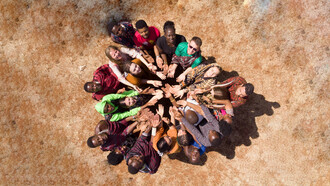If there is a worst-case scenario, I have already run through it. If there is another shoe, I have pulled it off my foot and thrown it just to see where it lands. (And now I need my shoe back.)
Many of the maladaptive ways in which I cope with being a human alive in 2024 get on my nerves. Somehow, somewhere along the way, I became somewhat of a hopeless cynicist convinced that my capacity for growth and change was limited. And, of course, we can ultimately become the stories we tell ourselves.
As human beings, we are largely encouraged to never become desensitized in the face of suffering and injustice. Part of countering this is to find hope and remain in that place so that we can continue to dream of and build better worlds.
But when it comes to my internal world, I have a much harder time applying this to myself. It is almost comical how we can opt to hurt our feelings to somehow save us from experiencing pain. We still end up in pain regardless, quite unnecessarily so.
I have recently begun to think about hope as a muscle and something that can be strengthened through practice and repetition. I am not sure when I got out of shape, but I have been wanting to get my form back ever since.
Hope feels amazing; it is almost too good to be true. It can get you out of bed in the morning, through your worst and lowest moments, and it is the fuel to push through when the world seems to be working against you.
Hope is knowing your value without reassurance; balancing the duality of self-doubt with self-love; trusting in some higher power; and knowing that, even in the face of constant uncertainty, something will work out.
Hope is the antidote to rejection, disappointment, and heartbreak. Some of the strongest people I have ever met hold steadfast to hope during tough times, and they do not turn against themselves. It is this last part that I have historically had a lot of trouble coping with.
Hope can keep us afloat only if we are doing work in the direction of the things we want. If nothing changes, nothing changes. Hope should drive our actions, which then directly impacts our ability to make things happen. Belief and action are powerhouses when paired together.
It is hard because you cannot always see hope, and its very existence relies on an invisible system of trust: Trust in the self, the goodness of others, and the balance of the universe. Without reassurance, we must have hope in that which we can’t see. Hope must come from some deeper part in our core that, even without specific evidence, knows that something will turn out and our lives will be better.
So, how exactly do we strengthen the muscle of hope?
Firstly, we label ‘hope’ as an ongoing process. You can’t just have hope once; it must be reinforced and refined like any other new practice.
Next, and most importantly, we must figure out our why and our what. Why is something important to us? What is it that we want to achieve? Without this information, it is impossible to start.
After the why comes the how. Break down those large, scary, complicated processes into daily actions. Hope is a marathon, not a sprint. The small things we do day-to-day became radical changes down the line. When we figure out a list of steps to follow in the direction of the thing(s) we want, we can start walking down the right path.
Here comes the hope piece: If we are aware of our motivations and our means of fulfilling them, we need to start believing in the invisible process. For no other reason than it being the wind in our hair in our short, human lives, we can choose hope and the understanding that something will work out and we will be okay.
We must tolerate uncertainty and not lose sight of our goals and dreams. Keep going. When you feel lost, feel it fully, but don’t lose your vision. So long as you have a beating heart in your chest, anything is possible. Be persistent in believing in the intangible, which is seemingly out of reach. If your gut is telling you to keep going–listen to it. Your gut knows things that your brain might not yet realize.
Combining theory and praxis, we can strengthen our hope muscle over time. We can make space for things to go right for once, and to use that space for when they do. Do the hard thing, take care of yourself throughout every stage, stay the course, and keep the faith. You never know when you’re one small step away from the finish line, and how good it can feel to cross it.















